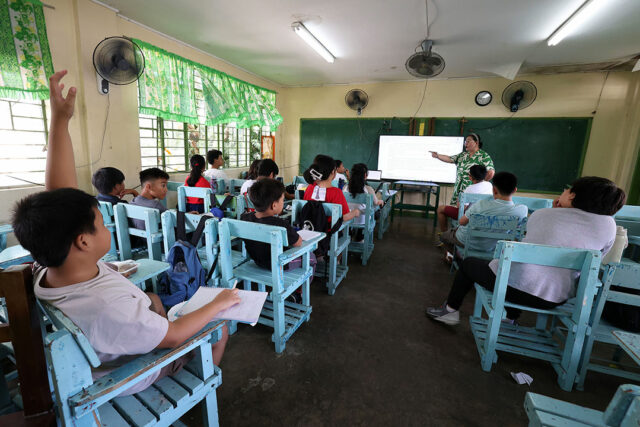LONDON — The custodians of trillions of dollars of global central bank reserves are eyeing a move away from the greenback into gold, the euro and China’s yuan as the splintering of world trade and geopolitical upheaval spark a rethink of financial flows.
According to a report by the Official Monetary and Financial Institutions Forum (OMFIF) due to be published later on Tuesday, one in three central banks managing a combined $5-trillion plan to increase exposure to gold over the next one to two years after stripping out those planning to decrease, the highest in at least five years.
The survey of 75 central banks — carried out between March and May — gives a first snapshot of the repercussions of US President Donald J. Trump’s April 2 Liberation Day tariffs that sparked market turmoil and a slide in the safe-haven dollar and US Treasuries.
Gold, which central banks have already been adding at a record pace, was seen benefiting even further longer term, with a net 40% of central banks planning to increase gold holdings over the next decade.
“After years of record-high central bank gold purchases, reserve managers are doubling down on the precious metal,” OMFIF said.
The dollar, the most popular currency in last year’s survey, fell to seventh place this year, OMFIF said, with 70% of those surveyed saying the US political environment was discouraging them from investing in the dollar — more than twice the share a year ago.
In currencies, the euro and yuan stand to benefit the most from a diversification away from the dollar.
A net 16% of central banks surveyed by OMFIF said they plan to increase euro holdings over the next 12 to 24 months, making it the most in-demand currency, up from 7% a year ago, followed by the yuan.
But over the next decade, the yuan is more favored, with a net 30% of central banks expecting to increase holdings and its share of global reserves seen tripling to 6%.
Separately, three sources who deal directly with reserve managers told Reuters they saw the euro as now having the potential to recapture the share of currency reserves lost following the 2011 euro debt crisis by the end of this decade. They cited more positive sentiment among reserve managers towards the euro following Liberation Day.
That would mean a recovery to a roughly 25% share of currency reserves, from around 20% currently, representing a key moment in the bloc’s recovery from the debt crisis that threatened the euro’s existence.
Max Castelli, head of global sovereign markets strategy and advice at UBS Asset Management, told Reuters that reserve managers made many calls after Liberation Day to ask if the dollar’s safe-haven status was at risk.
“As far as I remember, this question has never been asked before, not even after the great financial crisis in 2008.”
The average expectation for the dollar’s share of global foreign currency reserves in 2035 was 52%, the OMFIF survey showed, remaining the No. 1 reserve currency but seen down from the current 58%.
EURO’S MOMENT?
OMFIF survey respondents expected the euro to reach about a 22% share of global reserves in 10 years’ time.
“The euro’s share of global reserves will almost surely rise over the next few years, not so much because Europe is viewed so much more favorably, but because the dollar’s status is diminished,” said Kenneth Rogoff, Harvard professor and former International Monetary Fund chief economist, told Reuters by e-mail ahead of OMFIF’s publication.
But Europe could attract a higher share of reserves sooner if the bloc is able to boost its pile of bonds that are currently dwarfed by the $29-trillion US Treasury market, while integrating its capital markets, the sources that speak directly to reserve managers, told Reuters.
European Central Bank (ECB) President Christine Lagarde has also urged action to bolster the euro as a viable dollar alternative.
The euro is the “only real alternative currency for the moment to make a significant change in the level of reserves,” said Bernard Altschuler, global head of central bank coverage at HSBC, adding he saw it as “realistic” for the euro to reach a 25% share of global reserves in 2-3 years if those issues are addressed.
The European Union is the world’s largest trading bloc. Its economy is far bigger than the dollar’s other rivals. Capital controls limit the appeal of the yuan.
Momentum for change has gathered pace, with Europe signaling willingness to curb its dependence on the US by boosting defense spending, including through more joint EU borrowing. Germany is ramping up spending, while the EU is trying to revive efforts to integrate its capital markets.
Public pension and sovereign wealth funds, also surveyed by OMFIF, saw Germany as the most attractive developed market.
UBS Asset Management’s Castelli said he was receiving many more questions about the euro, estimating the euro could recover to a 25% share of reserves by the end of the 2020s.
At the most bullish end, Francesco Papadia, who managed the ECB’s market operations during the debt crisis, estimated the euro could recover to 25% in as soon as two years.
Reserve managers he holds discussions with were more willing to look at the euro than before, Papadia, senior fellow at think-tank Bruegel, said.
Zhou Xiaochuan, China’s central bank chief from 2002 to 2018, agreed the euro’s role as a reserve currency could grow. However, there’s “homework to do,” he told Reuters on the sidelines of a recent conference. — Reuters















